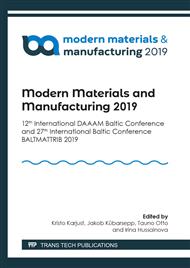[1]
X. Ren, R. Das, P. Tran, T.D. Ngo, Y.M. Xie, 2018 Auxetic metamaterials and structures: A review, Smart Mater. Struct. 27 (2018) Article ID 023001.
DOI: 10.1088/1361-665x/aaa61c
Google Scholar
[2]
Q. Liu, Literature review: Materials with negative Poisson's ratios and potential applications to aerospace and defence, Victoria, Australia, DSTO Defence Science and Technology Organization, (2006).
Google Scholar
[3]
C.P. Chen, R.S. Lakes, Viscoelatic behaviour of composite materials with conventional Poisson ration or negative Poisson ratio foam as one phase, J. Mater. Sci. 28 (1993) 4288-4298.
DOI: 10.1007/bf01154934
Google Scholar
[4]
C.P. Chen, R.S. Lakes, Micromechanical analysis of dynamic behaviour of conventional and negative Poisson's ratio foams, J. Eng. Mater. Technol. 118 (1996) 285-288.
DOI: 10.1115/1.2806807
Google Scholar
[5]
F. Scarpa, P.J. Tomlin, On the transverse shear modulus of negative Poisson's ratio honeycomb structures, Fatigue Fract. Engng. Mater. Struct. 23 (2000) 717–720.
DOI: 10.1046/j.1460-2695.2000.00278.x
Google Scholar
[6]
N.D. Duc, K. Seung-Eock, P.H. Cong, N.T. Anh, N.D. Khoa, Dynamic response and vibration of composite double curved shallow shells with negative Poisson's ratio in auxetic honeycombs core layer on elastic foundations subjected to blast and damping loads, Int. J. Mech. Sci. 133 (2017) 504–512.
DOI: 10.1016/j.ijmecsci.2017.09.009
Google Scholar
[7]
X. Wang, B. Wang, Z. Wen, L. Ma, Fabrication and mechanical properties of CFRP composite three-dimensional double-arrow-head auxetic structures, Compos. Sci. Technol. J. 164 (2018) 92–102.
DOI: 10.1016/j.compscitech.2018.05.014
Google Scholar
[8]
Yu.A. Rossikhin, M.V. Shitikova, Mathematical models of viscoelastic auxetics, Abst. of the 3d Int. Conf. on Mechanics of Composites, Bologna, Italy, 3-4 July, 2017, p.29.
Google Scholar
[9]
Yu.A. Rossikhin, M.V. Shitikova, A.I. Krusser, To the question on the correctness of fractional derivative models in dynamic problems of viscoelastic bodies, Mech. Res. Commun. 77 (2016) 44–49.
DOI: 10.1016/j.mechrescom.2016.09.002
Google Scholar
[10]
Yu.A. Rossikhin, M.V. Shitikova, The fractional derivative Kelvin-Voigt model of viscoelasticity with and without volumetric relaxation, IOP Conf. Series: Journal of Physics 992 (2018) Paper ID 012069.
DOI: 10.1088/1742-6596/991/1/012069
Google Scholar
[11]
Yu.N. Rabotnov, Creep of Structural Elements, Nauka, Moscow, 1966 (Engl. transl. by North-Holland, Amsterdam, 1969).
Google Scholar
[12]
S. Samko, A. Kilbas, O. Marichev, Fractional Integrals and Derivatives. Theory and Applications, Gordon & Breach, New York, (1993).
Google Scholar
[13]
Yu.A. Rossikhin, M.V. Shitikova, Centennial jubilee of Academician Rabotnov and contemporary handling of his fractional operator, Fract. Calculus Appl. Anal. 17 (2014) 674–683.
DOI: 10.2478/s13540-014-0192-2
Google Scholar
[14]
Yu.N. Rabotnov, Equilibrium of an elastic medium with after-effect, Fract. Calculus Appl. Anal. 17 (2014) 684–696.
DOI: 10.2478/s13540-014-0193-1
Google Scholar


